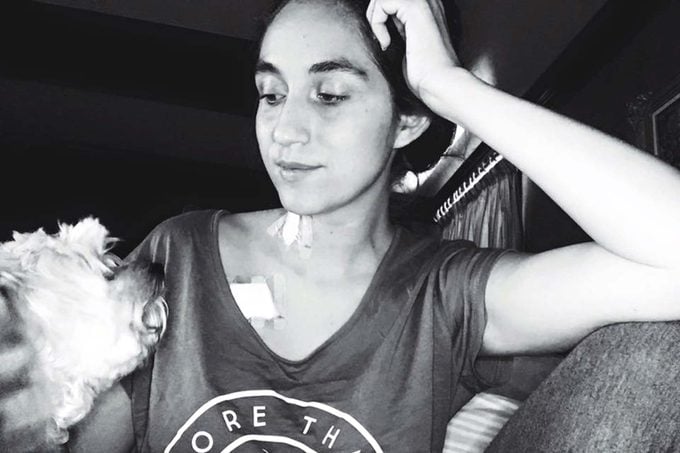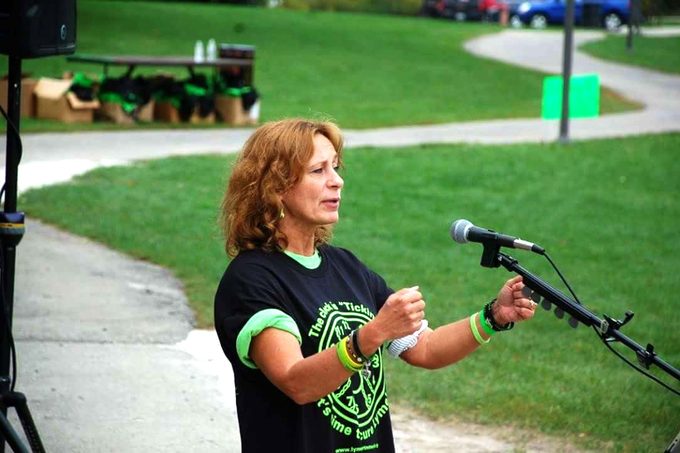Three Women Share What It’s Really Like to Live With Lyme Disease
Updated: Mar. 14, 2020
Three women share their stories about what it's really like to live with Lyme disease and offer advice for how to cope with the condition.
Lyme disease, which is caused by a type of bacteria called Borrelia that is transmitted through the bite of an infected tick, is the most common vector-borne illness in the U.S., according to the Centers for Disease Control and Prevention, Each year, there are 329,000 new cases of the disease. Lyme disease is highly treatable with antibiotics if it’s caught early. Some people get clear early signs, like a known tick bite and a spreading bull’s-eye rash; others do not. For those people, obtaining a proper diagnosis and treatment plan can be a tricky endeavor, including these three women who have coped with Lyme disease for years.
Jali Seefeldt, Appleton, Wisconsin

Over the years, I had many unusual symptoms (severe insomnia, allergies, migraines, etc.), but I never put the pieces together. I saw over 30 doctors and specialists and spent an entire week at a world-renowned hospital being evaluated for neurological issues, and not one physician could find anything wrong with me. One day, I mentioned to a client of mine that my symptoms were starting to present as multiple sclerosis (MS), and she encouraged me to do the western blot for Lyme disease. Sadly, no doctor ever diagnosed my Lyme, and I was never aware of a tick bite. It was my client who helped me get a proper diagnosis.
Since February 2013, I have tried everything I could get my hands on for Lyme disease treatment–tinctures, herbs, roots, spices, Ayurvedic medicine, Chinese medicine, homeopathy, vitamins, minerals, and more–pretty much everything that isn’t covered by insurance. It was more than a full-time job to keep track of and manage my meds, and my memory wasn’t working well at the time.
Now, I am very close to remission. I still take a handful of pills each day, but it’s nothing compared to when I was sick. I am able to work again, I am extremely active, and my Lyme disease symptoms are very minimal. My quality of life is pretty great most days. There will probably be some lingering symptoms for the rest of my life, and I’m OK with that. I just hope to maintain the health I’ve gotten back; I don’t ever want to relapse again. (Read about the new tick disease you need to know about.)
Jali’s advice to other patients:
If treatment is too much, ease up and allow your body to rest. The body is capable of amazing things if you give it the right tools to heal. Also, try to keep a positive attitude. Finally, there is an amazingly supportive Lyme community. Reach out. We all help each other so much.
Ina Melendez, Miami

The Lyme symptoms started around 2001, and I was misdiagnosed until 2014. Back when I was around 12 years old, I saw a bull’s-eye rash on my rib cage that we mistook as ringworm. Six months later, I had terrible stomach issues, pain behind my right shoulder blade, migraines, head pressure, anxiety, depression, knee pain, light and sound sensitivity, and back pain.
Fast forward to my last year in college: I was getting panic attacks, random fainting spells, severe anxiety, and unexplained allergic reactions. Eventually, I was hospitalized and had surgery for severe bloating and terrible pain in my lower abdomen; the pain never went away. Doctors wouldn’t listen to me, and I was so determined to follow my dreams that I sucked it up, graduated, and moved to Los Angeles to start a new job. Unfortunately, I was hit with arthritis, lupus, and MS-like symptoms. I had to move back in with my parents at the end of 2013.
After my diagnosis, my doctor said, “Just so you know, this will be a very long road–You definitely have chronic Lyme, and that can take years to get into remission.” I hoped I’d be an exception; I would cure this monster in six months! (Spoiler: That didn’t happen.) In the beginning, I was on 90 pills a day. Now, I take much less, and I’ve been undergoing Lyme disease treatment for three years. I’ve done a complete diet and lifestyle change–no toxins at all in any of my body products and even cleaning products.
The uncertainty, the loneliness, and the lack of doctors who truly understand Lyme are difficult aspects of this disease. My mind has gone to some really dark places, and it’s not easy to keep hope alive after setbacks and disappointment. Essentially, I try to find reasons to smile and laugh every day. At the end of the day, laughter and smiles are so big that it’s what helps me hang on to hope.
Ina’s advice to other patients:
If you’re not on Instagram, download the app now. There’s an entire community willing and happy to be there for you and navigate this mess with you. (Search #lymedisease.) Reach out to people and share stories; it helps to know you’re not alone. It’s nice to talk to someone who understands on a personal level.
Jennifer Scott, Chicago

At age 37, a downward spiral started; I had recurring Bell’s palsy, numbness and tingling in the fronts of my legs, neuropathy, disequilibrium, dizzy spells, seizures, depersonalization, and more. I felt like I was moving in a slow-motion dream and not participating in life. Like so many of my fellow Lyme friends, I didn’t recall seeing a tick bite or a rash. In 2005, after two years and 10 doctors, I got a Lyme disease diagnosis and co-infections.
After a dozen years with this disease, I’ve tried aggressive IV and oral antibiotics, seizures meds, meds for anxiety and depression, and pain medicines. In 2010, I switched to an integrative Lyme literate medical physician, who I am still with today. I’ve had two more peripherally inserted central catheter lines for IV antibiotics under his care, as well as, more oral antibiotics, antivirals, vitamins, and supplements. Because of this disease, I lost my career and my income. As a result, I still struggle with extreme guilt and feelings of worthlessness because I can’t contribute to my family in the way I used to.
Today, I would say that I am quite functional. When I overdo things, it sets me back and causes major symptom flares, so I have to pace myself. Most days, I am able to run a few errands, play with my grandkids, do a couple of chores, maybe go to a meeting or a class…If it’s a really good day I might hang with friends or go on a date night with my hubby. I think I’m about 70 percent of what I was pre-infection, and I’ll celebrate it.
Jennifer’s advice to other patients:
Right now, there is no cookie-cutter approach to healing people with Lyme because it is so vastly different for each individual. What works for one, may not work for another. You have to advocate for yourself and figure out what works best for you. But if something isn’t working, please do not give up. Always keep looking and keep trying! (Find out the 18 silent signs you could have Lyme disease.)